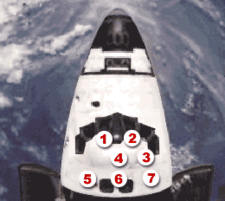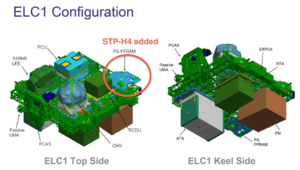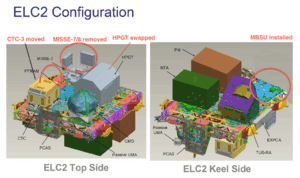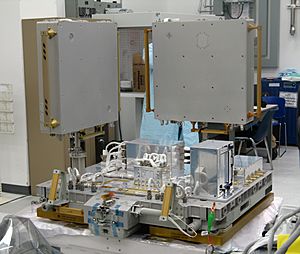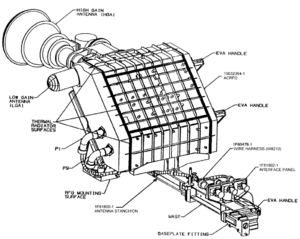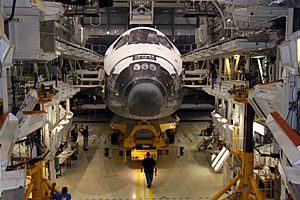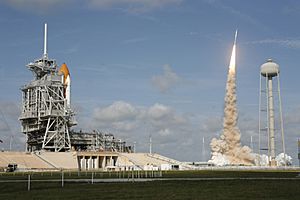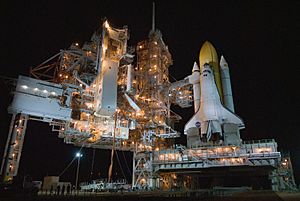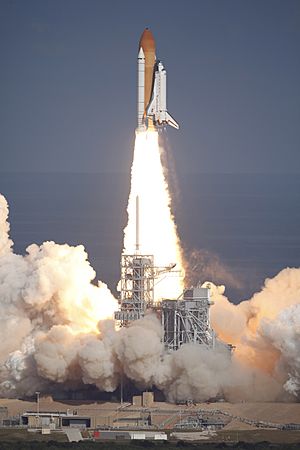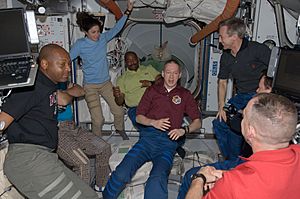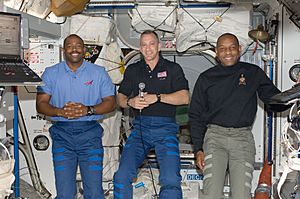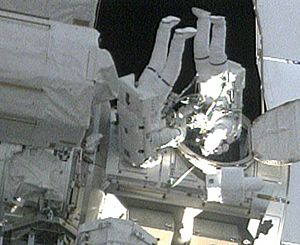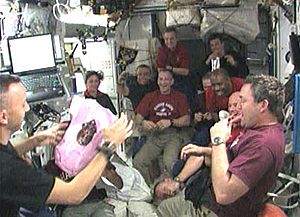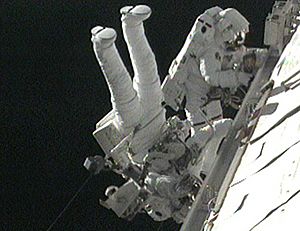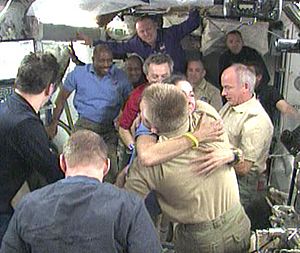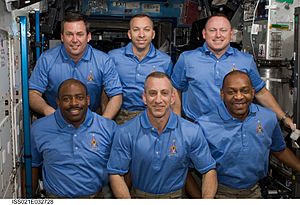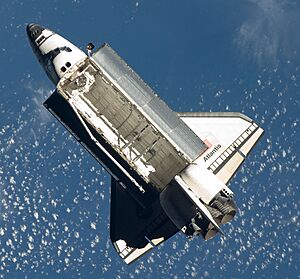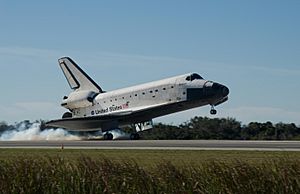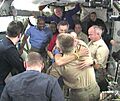STS-129 facts for kids

Bresnik (left) and Foreman (center) working on Columbus' exterior during the mission's second EVA
|
|
| Mission type | ISS logistics |
|---|---|
| Operator | NASA |
| Mission duration | 10 days 19:16:13 |
| Distance travelled | 7,226,177 kilometres (4,490,138 mi) |
| Orbits completed | 171 |
| Spacecraft properties | |
| Spacecraft | Space Shuttle Atlantis |
| Launch mass | 120,848 kilograms (266,424 lb) |
| Dry mass | 93,063 kilograms (205,168 lb) |
| Crew | |
| Crew size | 6 up 7 down |
| Members |
|
| Landing | |
| Start of mission | |
| Launch date | November 16, 2009, 19:28:09 UTC |
| Launch site | Kennedy LC-39A |
| End of mission | |
| Landing date | November 27, 2009, 14:44:22 UTC |
| Landing site | Kennedy SLF Runway 33 |
| Orbital parameters | |
| Reference system | Geocentric |
| Regime | Low Earth |
| Perigee | 343 kilometres (213 mi) |
| Apogee | 356 kilometres (221 mi) |
| Inclination | 51.6 degrees |
| Period | 91 minutes |
| Docking with ISS | |
| Docking port | PMA-2 (Harmony forward) |
| Docking date | November 18, 2009, 16:51 UTC |
| Undocking date | November 25, 2009, 09:53 UTC |
| Time docked | 6 days, 17 hours, 2 minutes |
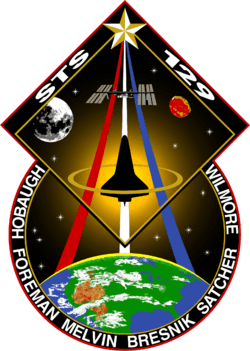 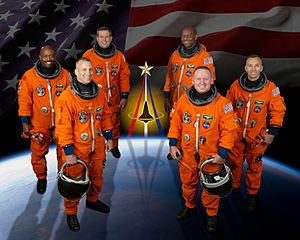 Front row (l–r) are Hobaugh and Wilmore. Back row (l–r) are Melvin, Foreman, Satcher and Bresnik. |
|
STS-129 was a NASA Space Shuttle mission to the International Space Station (ISS). The Space Shuttle Atlantis launched on November 16, 2009, and returned to Earth on November 27, 2009. This mission was important because it carried many spare parts to the space station. It was also the last Space Shuttle launch of the 2000s.
Contents
- What was the Main Goal of STS-129?
- Who were the Astronauts on STS-129?
- What Did the Shuttle Carry?
- What Experiments were Done on the Mission?
- Important Moments of the Mission
- Mission Timeline: A Day-by-Day Look
- November 16 (Flight Day 1 – Launch Day)
- November 17 (Flight Day 2 – Checking the Shuttle)
- November 18 (Flight Day 3 – Docking with ISS)
- November 19 (Flight Day 4 – First Spacewalk)
- November 20 (Flight Day 5 – Moving Cargo)
- November 21 (Flight Day 6 – Second Spacewalk)
- November 22 (Flight Day 7 – Rest Day)
- November 23 (Flight Day 8 – Third Spacewalk)
- November 24 (Flight Day 9 – Saying Goodbye)
- November 25 (Flight Day 10 – Undocking)
- November 26 (Flight Day 11 – Getting Ready for Landing)
- November 27 (Flight Day 12 – Landing Day)
- Spacewalks During STS-129
- Wake-up Calls: Music in Space
- What did the Mission Patch Mean?
- Images for kids
- See also
What was the Main Goal of STS-129?
The main goal of STS-129 was to deliver spare parts to the ISS. These parts were stored outside the station. The mission lasted 11 days and included three spacewalks. The shuttle carried two large carriers called ExPRESS Logistics Carriers (ELCs). These ELCs held important spare parts like gyroscopes, nitrogen tanks, and pump modules. This was the first time an ExPRESS Logistics Carrier was flown into space.
Who were the Astronauts on STS-129?
The STS-129 mission had a crew of six astronauts who went up to space, and one astronaut who came back down from the ISS.
- Commander: Charles O. Hobaugh (his third and last space flight)
- Pilot: Barry E. Wilmore (his first space flight)
- Mission Specialist 1: Leland D. Melvin (his second and last space flight)
- Mission Specialist 2: Randolph J. Bresnik (his first space flight)
- Mission Specialist 3: Michael J. Foreman (his second and last space flight)
- Mission Specialist 4: Robert L. Satcher Jr. (his only space flight)
- Returning from ISS: Nicole M. P. Stott (her first space flight)
Nicole Stott was already on the ISS as part of Expedition 21. She returned to Earth with the STS-129 crew. This mission was the last time a Space Shuttle crew rotated astronauts to or from the ISS. It was also the second time two African-American astronauts, Leland Melvin and Robert Satcher, flew on the same Space Shuttle mission.
How were the Crew Seats Arranged?
The astronauts had specific seats for launch and landing.
| Seat | Launch | Landing | |
|---|---|---|---|
| S1 | Charles Hobaugh | Charles Hobaugh | |
| S2 | Barry Wilmore | Barry Wilmore | |
| S3 | Leland Melvin | Randolph Bresnik | |
| S4 | Randolph Bresnik | Leland Melvin | |
| S5 | Michael Foreman | Michael Foreman | |
| S6 | Robert Satcher | Robert Satcher | |
| S7 | – | Nicole Stott |
What Did the Shuttle Carry?
The Atlantis shuttle carried many important items to the ISS. Here are some of the main things:
| Location | Cargo | Mass |
|---|---|---|
| Bays 1–2 | Orbiter Docking System EMU (spacesuits) |
1,800 kilograms (4,000 lb) ~260 kilograms (570 lb) |
| Bays 6–9 | EXPRESS Logistics Carrier ELC-1 | 6,396 kilograms (14,101 lb) |
| Bays 10–13 | EXPRESS Logistics Carrier ELC-2 | 6,136 kilograms (13,528 lb) |
| Starboard Sill | Orbiter Boom Sensor System | ~382 kilograms (842 lb) |
| Port Sill | Canadarm 301 | 410 kilograms (900 lb) |
| Total: | 16,027 kilograms (35,333 lb) |
What are ExPRESS Logistics Carriers?
The main cargo for STS-129 was the ExPRESS Logistics Carrier (ELC-1) and ELC-2. These are like large, strong shelves made of steel. They can hold a lot of weight, about 9,800 pounds (4,400 kg) each. They also have a lot of space, about 30 cubic meters.
ELC-1 carried spare parts like an Ammonia Tank, a Battery Charger, a robotic arm part, a Control Moment Gyroscope, a Nitrogen Tank, and a Pump Module. ELC-2 carried a High Pressure Gas Tank (filled with oxygen), a Cargo Transport Container, another Control Moment Gyroscope, a Nitrogen Tank, and a Pump Module. These carriers were attached to different parts of the ISS.
What was the MISSE Experiment?
ELC-2 also carried MISSE-7. This experiment exposes different materials and coatings to the harsh conditions of space. Scientists want to see how these materials react to things like atomic oxygen, ultraviolet light, sunlight, radiation, and extreme hot and cold. The results help engineers design better spacecraft that can last longer in space.
MISSE-7 has two parts, MISSE 7A and MISSE 7B, which look like suitcases. Astronauts open them once they are installed outside the ISS. Some experiments are active (they collect data during the mission), and some are passive (they are studied back on Earth after the mission).
What was the S-band Antenna Sub-Assembly (SASA)?
Atlantis delivered a repaired S-band Antenna Sub-Assembly (SASA) to the ISS. This is an antenna system that helps the space station communicate. It sends and receives radio signals to and from satellites like the Tracking Data and Relay Satellite. The SASA package was installed on the ISS by astronauts during a spacewalk.
What was the SpaceX COTS UHF Communication Unit?
Atlantis also carried a special communication unit called the COTS UHF Communication Unit (CUCU). This unit was developed by SpaceX to help the ISS talk to SpaceX's Dragon spacecraft. It allows commands to be sent from SpaceX to the Dragon, and data from Dragon to be sent back to Earth. There's also a Crew Command Panel that lets astronauts on the ISS monitor and send simple commands to the Dragon spacecraft.
Other Interesting Items Flown to Space
- Astronaut Randolph Bresnik carried a scarf that belonged to the famous pilot Amelia Earhart. His grandfather was her personal photographer. The scarf was later displayed in a museum.
- The official coin for the Super Bowl XLIV coin toss was flown on this mission.
- A football signed by members of the Pro Football Hall of Fame and other NFL items also went to space.
What Experiments were Done on the Mission?
The Atlantis crew worked on several experiments during their mission. Some were short-term, and others were new long-term experiments for the ISS. The shuttle also brought completed experiments back to Earth.
Short-Term Experiments
- Shuttle Exhaust Ion Turbulence Experiments (SEITE): This experiment studied how the shuttle's engine exhaust affects the Earth's upper atmosphere (ionosphere). It helps scientists understand how these changes can impact radio communications and tracking objects in space.
- Shuttle Ionospheric Modification with Pulsed Localized Exhaust Experiments (SIMPLEX): This experiment also looked at how shuttle exhaust creates turbulence in the ionosphere. This research helps improve military communication systems and could even help open new radio channels.
New Experiments for the Space Station
- Microbe experiment: Students from Texas Southern University designed this experiment to study how microbes (like Escherichia coli and Bacillus subtilis) grow in space without gravity.
- Butterflies in Space Program: The shuttle carried larvae of painted lady and monarch butterflies. Researchers compared these space caterpillars with ones raised on Earth by students.
- Advanced Plant Experiments on orbit (APEX-Cambium project): This project, by the Canadian Space Agency and NASA, studies how gravity affects wood formation in trees. It also looks at how space stress affects plant genes.
- Caenorhabditis elegans worms: Thousands of tiny worms were sent to the ISS from the University of Nottingham, UK. These worms lose muscle in space, similar to humans. Scientists will study them to find ways to treat muscle loss in astronauts.
Important Moments of the Mission
The STS-129 mission marked several milestones:
- It was the 160th NASA crewed space flight.
- The 129th Space Shuttle mission.
- The 31st flight of Atlantis.
- The 31st shuttle mission to the ISS.
- The 5th shuttle flight in 2009.
- The 16th mission after the Columbia disaster.
NASA also held its fifth "Tweetup" event during this launch. One hundred people from different countries attended the event at Kennedy Space Center. They used the hashtag #nasatweetup, which became very popular on Twitter.
Launch Preparations
The Atlantis shuttle was moved to the Vehicle Assembly Building (VAB) on October 6, 2009. It was then moved to Launch Pad 39A on October 14, 2009. This move, done by a special Crawler-transporter, took several hours.
Before the launch, NASA managers checked everything to make sure the shuttle was ready. They even approved a special camera to film the external fuel tank during launch. This helped them study how ice and foam behaved during liftoff.
On November 13, 2009, the final launch preparations began. The crew flew to Kennedy Space Center, and the countdown clock started. On November 16, 2009, the external tank was loaded with fuel. The weather forecast was good, and the mission management team gave the final "go" for launch.
Mission Timeline: A Day-by-Day Look
November 16 (Flight Day 1 – Launch Day)
Atlantis launched exactly on time at 2:28 PM EST (19:28 UTC). The launch was perfect. The main engines shut down about eight minutes after liftoff, and the external tank separated shortly after. The shuttle then adjusted its orbit to get closer to the ISS.
NASA officials later confirmed that there were no major issues with foam loss from the external tank during launch. The crew opened the shuttle's payload bay doors, set up communications, and prepared the robotic arm for inspections.
November 17 (Flight Day 2 – Checking the Shuttle)
The crew started their first full day in space by inspecting Atlantis's heat shield. They used the shuttle's robotic arm and a special boom (OBSS) to check for any damage from launch. The inspection took about six hours.
The images and videos were sent to experts on the ground for review. They found no significant damage to the heat shield. The crew also prepared for docking with the space station on Flight Day 3. The spacewalkers tested their spacesuits.
November 18 (Flight Day 3 – Docking with ISS)
Atlantis moved closer to the ISS. Before docking, Commander Charles Hobaugh performed a special flip maneuver called the Rendezvous Pitch Maneuver (RPM). This allowed astronauts on the ISS to take pictures of Atlantis's underside to check its heat shield.
Atlantis successfully docked with the ISS at 16:51 UTC. The two spacecraft were orbiting 220 miles above Earth. After safety checks, the hatch between Atlantis and the ISS opened at 18:28 UTC. The crews greeted each other and began working together. Astronaut Nicole Stott, who had been on the ISS, officially joined the Atlantis crew for her return to Earth.
Later, the shuttle's robotic arm moved the ExPRESS Logistics Carrier 1 (ELC-1) out of the payload bay and handed it over to the station's robotic arm, Canadarm2. ELC-1 was then attached to the ISS.
November 19 (Flight Day 4 – First Spacewalk)
NASA confirmed that Atlantis's heat shield was clear for re-entry. The main event was the first spacewalk (EVA 1) by astronauts Michael Foreman and Robert Satcher. They wore special spacesuits to work outside the station. They installed a spare antenna and a bracket for ammonia lines. They also did some "get ahead" tasks, finishing work earlier than planned.
This spacewalk was the 228th spacewalk by U.S. astronauts and the 134th to support the space station. Nicole Stott celebrated her 47th birthday in space.
Later, a false alarm for depressurization woke the crew. After checks, it was confirmed that the station was safe.
November 20 (Flight Day 5 – Moving Cargo)
The crew spent the day moving cargo between the shuttle and the station. They completed more than half of the mission's transfer activities. Inside the station, crew members also prepared the Unity node for the arrival of the Tranquility module on a future mission.
Several crew members talked with reporters on Earth about their mission and what it's like to be in space. The crew also got ready for the second spacewalk. For the second night in a row, false alarms (fire and depressurization) sounded in the station, waking the astronauts.
November 21 (Flight Day 6 – Second Spacewalk)
The main activity was the second spacewalk (EVA 2) by astronauts Michael Foreman and Randolph Bresnik. The spacewalk was shortened and delayed due to the false alarms from the night before. However, they finished all their assigned work and even completed some tasks planned for the third spacewalk. This was Foreman's fifth spacewalk and Bresnik's first.
Earlier, the shuttle's robotic arm moved ExPRESS Logistics Carrier 2 (ELC-2) out of the shuttle and handed it to the station's robotic arm. ELC-2 was then attached to the ISS.
November 22 (Flight Day 7 – Rest Day)
The day started with exciting news: Randolph Bresnik's daughter, Abigail Mae Bresnik, was born! He became the second astronaut to become a father while in space.
The crew had a half-day off and talked with reporters. Some astronauts continued to transfer equipment and investigate the false alarms. Preparations for the third and final spacewalk also continued.
November 23 (Flight Day 8 – Third Spacewalk)
The main activity was the third and final spacewalk (EVA 3) by astronauts Robert Satcher and Randolph Bresnik. The spacewalk started a bit late because of a small issue with Satcher's spacesuit drink bag.
They completed all their main tasks and extra "get ahead" work. This was the 230th spacewalk by U.S. astronauts. Satcher installed a new High Pressure Gas Tank, and Bresnik installed the MISSE-7 experiments. They also moved some shields and prepared for future spacewalks.
November 24 (Flight Day 9 – Saying Goodbye)
The Atlantis astronauts used the shuttle's thrusters to boost the space station to a slightly higher orbit. Final cargo transfers continued throughout the day. They moved about 1,400 pounds of water to the ISS and brought back about 2,100 pounds of experiments and items.
A false smoke and fire alarm sounded in the Japanese Kibo laboratory, likely due to stirred-up dust. This was the third false alarm during the mission. The crews held a news conference, and Expedition 21 astronaut Robert Thirsk noted that the space station was almost 86% complete.
Later, Station Commander Frank De Winne handed over his command to astronaut Jeffrey Williams. This was the first time a command change happened during a shuttle mission at the ISS. At 18:12 UTC, the hatches between Atlantis and the ISS were closed, ending nearly six days of joint work.
November 25 (Flight Day 10 – Undocking)
The shuttle and the space station undocked at 09:53 UTC. They had been docked for 6 days, 17 hours, and 2 minutes. After undocking, Pilot Barry Wilmore flew Atlantis around the station for a final look. Then, Atlantis performed burns to move away from the ISS.
Astronauts found a problem with the shuttle's waste water tank, as the flow was reduced. They inspected the nozzle but found no ice, suggesting a blockage. The crew also performed a final inspection of the shuttle's heat shield using the robotic arm and OBSS.
November 26 (Flight Day 11 – Getting Ready for Landing)
This was the crew's last full day in space. It was also Thanksgiving Day in the U.S., making it the eighth shuttle mission to celebrate Thanksgiving in space. NASA confirmed that Atlantis's heat shield was completely clear for re-entry.
The crew spent the day stowing items inside the shuttle and testing its re-entry systems. They checked the flight control system and test-fired the thrusters that control the shuttle's direction during descent. All seven crew members took a break to talk with news reporters.
November 27 (Flight Day 12 – Landing Day)
With good weather at Kennedy Space Center, the flight director gave the "go" for landing. The payload bay doors were closed, and the astronauts began "fluid loading" to help their bodies adjust to gravity.
Atlantis fired its engines for a deorbit burn at 13:37 UTC, slowing down to begin its descent. It entered Earth's atmosphere at 14:12 UTC. The shuttle touched down on Runway 33 at Kennedy Space Center at 14:44:23 UTC. This was the 72nd Space Shuttle landing at Kennedy Space Center.
After landing, Commander Charles Hobaugh announced, "Houston, Atlantis, wheels stop." The crew then exited the shuttle and performed a traditional walk-around. Hobaugh said it was "truly an amazing mission." Astronauts Randolph Bresnik and Nicole Stott were not at the post-landing conference. Bresnik went home to see his new baby daughter, and Stott underwent medical checkups after her long stay on the ISS.
Spacewalks During STS-129
Three spacewalks were performed during the STS-129 mission.
| EVA | Spacewalkers | Start (UTC) | End (UTC) | Duration |
|---|---|---|---|---|
| EVA 1 | Michael Foreman Robert Satcher |
November 19, 2009 14:24 UTC |
November 19, 2009 21:01 UTC |
6 hours, 37 minutes |
| Astronauts installed a spare antenna on the station and a bracket for ammonia lines. They also lubricated parts of the station's robotic arm and deployed a system for attaching cargo. | ||||
| EVA 2 | Michael Foreman Randolph Bresnik |
November 21, 2009 14:31 UTC |
November 21, 2009 20:39 UTC |
6 hours, 8 minutes |
| Astronauts installed a bracket on the Columbus laboratory and an extra ham radio antenna. They also installed an antenna for wireless helmet camera video and moved a unit that measures electrical potential around the station. | ||||
| EVA 3 | Robert Satcher Randolph Bresnik |
November 23, 2009 13:24 UTC |
November 23, 2009 19:06 UTC |
5 hours, 42 minutes |
| Satcher installed a new High Pressure Gas Tank. Bresnik took the MISSE-7 experiments from Atlantis's cargo bay and installed them. They also removed shields and prepared heater cables for a future module installation. | ||||
Wake-up Calls: Music in Space
NASA has a tradition of playing music to wake up astronauts. Each song is chosen by their families or has a special meaning to the crew.
| Flight Day | Song | Artist | Played for | Links |
|---|---|---|---|---|
| Day 2 | "I Can Only Imagine" | MercyMe | Barry E. Wilmore | - |
| Day 3 | "Higher Ground" | Stevie Wonder | Robert Satcher | - |
| Day 4 | "In Wonder" | Newsboys | Randolph Bresnik | - |
| Day 5 | "We Are Family" | Sister Sledge | Leland Melvin | - |
| Day 6 | "Voyage to Atlantis" | The Isley Brothers | Robert Satcher | - |
| Day 7 | "Butterfly Kisses" | Bob Carlisle | Randolph Bresnik celebrating the birth of his daughter, Abigail Mae Bresnik hours earlier | - |
| Day 8 | "Space Rise" | Larry Whitehair | Michael Foreman | - |
| Day 9 | "The Marine Corps Hymn" | The Marine Corps Band | Charles O. Hobaugh | - |
| Day 10 | "Amazing Grace" from the 1995 movie Braveheart | Eric Rigler on bagpipes | Barry E. Wilmore | - |
| Day 11 | "Fly Me to the Moon" | Frank Sinatra | Nicole Stott | - |
| Day 12 | "Home Sweet Home" | Mötley Crüe | STS-129 Crew | - |
What did the Mission Patch Mean?
The mission patch for STS-129 was designed by Tim Gagnon and Dr. Jorge Cartes. Its unique shape showed that the mission's main goal was to deliver equipment for the ISS.
The patch included symbols like the Sun, Moon, Mars, and the NASA astronaut symbol. It also showed the ISS, the Space Shuttle, and the continental United States. The 13 stars on the patch represented the crew members' children. The Moon and Mars symbolized the future of space exploration. The names of the crew members were written around the edge of the patch.
Images for kids
See also
 In Spanish: STS-129 para niños
In Spanish: STS-129 para niños


